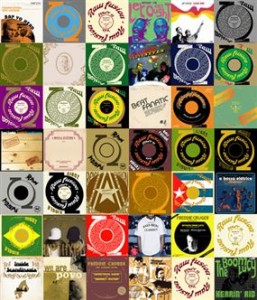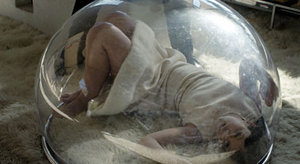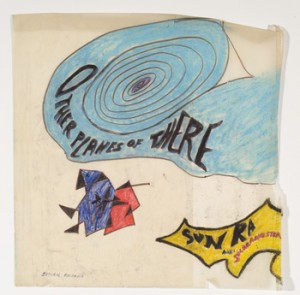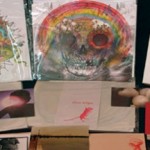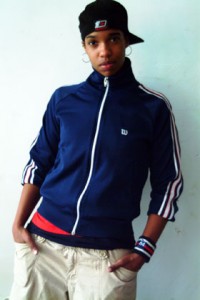Interview
XLR8R
December 2006
Link

House music has eccentric artists aplenty, but few can consistently turn out tracks with the twisted humor of Greenskeepers and keep a straight face. A live house outfit from Chicago, started by former golf caddies Nick Maurer and James Curd, the group delivers serious, floor-burning funk amped up with silly and endearing lyrics. They’ve turned The Silence of the Lambs psycho Buffalo Bill into a house diva (on “Lotion”) and revived the career of Fantasy Island midget Hervé Villechaize in the music video for their song “Filipino Phil.”
Now a quartet–with the inclusion of bassist Coban Rudish and guitarist/keyboardist Mark Share–Greenskeepers has just released Polo Club on San Francisco’s OM Records. Overflowing with loony lyrics and an excellent Huey Lewis cover, it begs the question: Where do these guys come up with this stuff? XLR8R spoke with Rudish, who comes from a very animated and artistically inclined family, about where he gets his creative inspiration.
XLR8R: Tell me about your brother, who works as an animator.
Coban Rudish: My older brother Paul started out as a character designer on the Batman cartoon, then worked at Hanna-Barbera. Then he moved on to [Cartoon Network show] Dexter’s Laboratory as a character designer and storyboarder, which led to Powerpuff Girls. Then he did Clone Wars, the Star Wars cartoon, and won an Emmy for it. Now he’s trying to start his own studio in partnership with the Orphanage, a computer-effects studio that wants to do 3-D features. They already hired on Genndy Tartakovsky (who created Dexter’s Laboratory and Powerpuff Girls). Paul is kind of Tartakovsky’s right-hand man. And he is a dork just like me. We talk about Star Wars all the time and have our own dork support system.
It seems like this creativity is a very big part of the family, since your dad Rick also drew.
It was a big part of growing up in my household, since my dad was an artist. But his main interest was horses. While he was in veterinary school, he was caught drawing a horse by an art teacher, who then got him to switch to art school. He graduated in 1964 and was recruited by Hallmark. He was drafted to go to Vietnam before he could start, but avoided real service by doing propaganda illustrations. After he finished that, he went to work at Hallmark. Then my dad started up a little farm and raised horses. The cutesy Hallmark art was kind of his way to afford his hobby. He also judged horse shows and was actually pretty high up in the Arabian Horse Association, which is unfortunately now associated with that dumbass [Michael] Brown, [director of FEMA during Hurricane Katrina].
Did you and Paul draw a lot with your father?
We would sit in his studio, across his drawing table in our high chairs, and draw along. Of course, when my dad would put on a Bee Gees record’ would get distracted and dance, while Paul would keep drawing.
How did your dad become involved with Rainbow Brite?
Hallmark decided they needed a property to compete with Strawberry Shortcake. My dad was asked to help create the character. Of course, my dad put a horse in it. Mattel picked up licenses to do toys, and then it kicked into gear and they made a full-length movie.
Did you get to work on the movie at all, since you were a kid at the time?
My dad went to work for the studio that made the movie–he was the art director–so Paul and I got to go and help design characters. Our names are in the credits as character designers. I designed the wise old wizard-sprite in the movie. Paul and I got to sit in with the writers, kind of like kiddie consultants.
Was there any notoriety to being the kid whose dad created Rainbow Brite?
I definitely tried to use it to my advantage trying to get the girls at school to have a crush on me. That’s also the reason I started playing music, I’m not afraid to admit.
How does Greenskeepers capture that sense of fun so many bands lack?
I think it’s a little more magical than that. Nick and Jim started Greenskeepers, and Nick is just a silly dude. He’s just a crazy, fantastical mind. At the same time, that vibe comes naturally for all of us.
How did you guys come up with “Lotion?”
I think Nick came up with the idea. Mark came up with the guitar riff and Nick just started flowing with the creepiness. I personally thought the song was a joke, and lo and behold, it was the breakout hit of the record.
Was it tough for you to adapt to playing house music?
In my mind, it was electronic disco, in many ways. I was disappointed with the way the hip-hop stole from all these old records I had. It was like, if you like that beat, let me play you the real song by Roy Ayers, because it’s even better. But James is so good at disguising, and picking and editing things.
What inspired Polo Club?
The title track was one of Nick’s whims. He started singing “polo club” over and over again. We were like, ‘Why the hell do you want to get into the damn polo club?’ We try not to be political–we usually just try to put some humor back into things–but it was a ‘Screw you’ to rich people. And once Mark re-edited it, it sounded awesome.
It seems like a real ’80s vibe is going on here with the Huey Lewis cover and the Talking Heads-style singing.
People talk about the David Byrne stuff, but that’s just what came out. We weren’t thinking about it at the time. I grew up in the ’80s, so when I started digging in my mind for rock riffs, that’s what I looked for. We’re products of where we came from, and I listened to a lot of INXS songs growing up.
